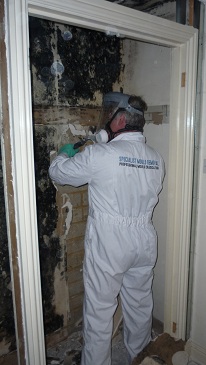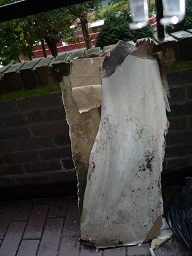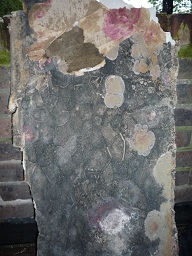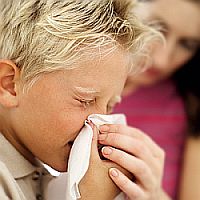WE ERADICATE & KILL THE MOULD IN YOUR PROPERTY ! AND NOT COVER IT !
London - Hampshire - West Sussex - Surrey
Due to the health concerns connected with black mould, It is advised that it is only removed whilst wearing
personal protection equipment and respiratory apparatus. 
Environmental Health Professional Practice - Mould Fungal Spores 1985 refers. The British Medical Journal report, Damp Housing, Mould Growth and Symptomatic Health State 24/6/89, confirms that active spores, even in small concentrations, are detrimental to the well being of adults and children.
.jpg)
Since 2004 Mould has been classed as a Category 1 risk to health as assessed under the Housing Health and Safety Rating System 2006 (HHSRS).
A mould infestation is comparable to an iceberg, whereby only a third of the problem is visible the remaining two thirds consists of a complex root system deep in the building substrate.
Mould spores are everywhere, and is a factor which is increased by modern living, double glazing, showers, central heating etc all help to cause condensation creating the ideal conditions for mould to thrive.


You may find that you have a small patch of mould showing on a part of a wall in your property, but quite often behind the plaster board lays a bigger problem.
Here is a photograph of a section of plasterboard that was removed from a recent mould removal job that we completed. This particular problem stemmed from a small amount of flood damage.
The second photo shows just how severe the mould can be behind on the back of the plaster board.
This photo illustrates what may lie on the back of the plaster board.
This particular section of plaster board had to be completely removed in order to stem the mould growth and remove the hazard.


The health concerns to people from untreated mould are very real, statistics show that 1 in 4 asthma suffers in the UK are linked to areas infested with mould, and it is thought that their illness is caused from the direct link to mould inhalation, ignoring the problem is unwise.
Mould starts life as a spore which is comparable with a seed from the vegetable kingdom, spores are minute, and the more humid the air the greater the concentration of spores.
Air currents allow mould spores to travel long distances, where they will find a humid location in which to root themselves and start to germinate.
Every property has within its structure mould spores which are dormant. However given the right conditions these spores germinate resulting in extensive growths of black disfiguring mould.
Different mould species can have varying health effects, but it is important to remember that any excessive mould growth needs to be taken care of, regardless of the species. Any excessive mould growth can lead to increased allergies, toxicity, and house/building structural problems.
Aspergillus spp
Aspergillus is the most common genus of fungi in our environment with more than 160 different species of mould. Sixteen of these species have been documented as causing human disease. Aspergillosis is now the 2nd most common fungal infection requiring hospitalization in the United States.
Aspergillus fumigatus. The most encountered species causing infection. It is seen abundantly in decomposing organic material, such as self-heating compost piles, since it readily grows at temperatures up to 55 C. People who handle contaminated material often develop hypersensitivity to the spores of Aspergillus and may suffer severe allergic reactions upon exposure.
Aspergillus flavus. The 2nd most encountered fungi in cases of Aspergillus infection. It is also known to produce the mycotoxin aflatoxin, one of the most potent carcinogens known to man. In the 1960s, 100,000 turkey poults in Britain died from ingesting contaminated feed. Most countries have established levels for aflatoxin in food. However, the risks associated with airborne exposure are not adequately studied and no exposure standards exist.
Aspergillus niger. The 3rd most common Aspergillus fungi associated with disease and the most common of any Aspergillus species in nature due to it’s ability to grow on a wide variety of substrates. This species may cause a “fungal ball”, which is a condition where the fungus actively proliferates in the human lung, forming a ball. It does so without invading the lung tissue.
Stachybotrys chartarum (atra)
This group of moulds can thrive on water damaged, cellulose-rich material in buildings such as sheet rock, paper, ceiling tiles, insulation backing, wallpaper, etc. In the majority of cases where Stachybotrys is found indoors, water damage has gone unnoticed or ignored since it requires extended periods of time with increased levels of moisture for growth to occur. Stachybotrys is usually black and slimy in appearance. Events of water intrusion that are addressed quickly tends to support the growth of more xerophilic fungi such as Pencillium and Aspergillus.
Stachybotrys is another fungi that has the ability to produce mycotoxins, ones that are extremely toxic, suspected carcinogens, and immunosuppressive. Exposure to these mycotoxins can result through inhalation, ingestion, and dermal exposure. Symptoms of exposure include dermatitis, cough, rhinitis, nose bleeds, cold and flu-like symptoms, headache, general malaise, and fever.
Cladosporium spp.
These genera of mould are pigmented dark green to black in the front, and black on the reverse with a velvety to powdery texture. One of the most commonly isolated from indoor and outdoor air, Cladosporium spp. are found on decaying plants, woody plants, food, straw, soil, paint, textiles, and the surface of fiberglass duct liner in the interior of supply ducts.
There are over 30 species in the Cladosporium genus. The most common are C. elatum, C. herbarum, C. sphaerospermum, and C. cladosporioides. These fungi are the causative agents of skin lesions, keratitis, nail fungus, sinusitis, asthma, and pulmonary infections. Acute symptoms of exposure to Cladosporium are edema and bronchiospasms, and chronic exposure may lead to pulmonary emphysema.
Fusarium spp.
A common soil fungus and inhabitant on a wide array of plants, this fungi is often found in humidifiers and has been isolated from water-damaged carpets and a variety of other building materials. Human exposure may occur through ingestion of contaminated grains and possibly through the inhalation of spores. Fusarium spp. are frequently involved with eye, skin, and nail infections. More severely it can produce hemorrhagic syndrome (alimentary toxic aleukia) in humans which is characterized by nausea, vomiting, diarrhea, dermatitis, and extensive internal bleeding.
Several species can produce the trichothecene toxins which target the circulatory, alimentary, skin, and nervous systems. Vomitoxin is one such tricothecene mycotoxin that has been associated with outbreaks of acute gastrointestinal illness in humans. Zearalenone is another mycotoxin produced by Fusarium. It is similar in structure to the female sex hormone estrogen and targets the reproductive organs.
Penicillium spp.
These fungi are commonly found in soil, food, cellulose, grains, paint, carpet, wallpaper, interior fiberglass duct insulation, and decaying vegetation. Penicillium may cause hypersensitivity pneumonitis, asthma, and allergic alveolitis in susceptible individuals.
The genus Penicillium has several species. The most common ones include Penicillium chrysogenum, Penicillium citrinum, Penicillium janthinellum, Penicillium marneffei, and
Penicillium purpurogenum.
This fungi has been isolated from patients with keratitis, ear infections, pneumonia, endocarditis, peritonitis, and urinary tract infections. Penicillium infections are most commonly exhibited in immunosuppressed individuals. For example, P. marneffei is a fungus abundant in Southeast Asia that typically infects patients with AIDS in this area. Infection with P.marneffei is acquired via inhalation and initially results in a pulmonary infection and then spreads to other areas of the body (lymphatic system, liver, spleen, and bones), and is often fatal. An indication of infection is the appearance of papules that resemble acne on the face, trunk, and extremities.
Penicillim spp. do have the ability to produce mycotoxins. The mycotoxin known as Ochratoxin A, which is nephrotoxic and carcinogenic, may be produced by Penicillium verrucosum. Verrucosidin is another mycotoxin produced by this fungus that exhibits neurotoxity. Penicillic acid is another mycotoxin that is nephrotoxic (causes kidney and liver damage).
Mycotoxins
During the digestion of substrates, fungi secrete enzymes into nutrients in order to break down complex compounds into simpler compounds that can be taken up by the fungi and used as nutrition. These digested nutrients produce secondary metabolic byproducts called mycotoxins that are released to give the fungi a competitive edge over other microorganisms and fungi. Unfortunately, mycotoxins can also be incredibly toxic to humans causing a variety of responses including cold/flu-like symptoms, sore throats, headaches, nose bleeds, fatigue, diarrhea, dermatitis, and immune suppression. Some mycotoxins may also be carcinogenic and teratogenic. Moulds that have been known to potentially produce these toxins are Acremonium, Alternaria, Aspergillus, Chaetomium, Cladosporium, Fusarium, Penicillium, and Stachybotrys.
Even though these moulds may potentially produce mycotoxins, they will not do so unless specific environmental conditions exist. Currently, it is unknown exactly what conditions promote the growth of mycotoxin production and more scientific research needs to be conducted on this topic for it to be fully understood.
Types of Mycotoxins
Aflatoxin . This mycotoxin is primarily produced by Aspergillus species. It is one of the most potent carcinogens known to man and has been linked to a wide array of human health problems. The FDA has established a maximum allowable level of total aflatoxin in food commodities of 20 parts per billion (ppb) and the maximum level for aflatoxin in milk products is 0.5 ppb.
Ochratoxin . This mycotoxin is primarily produced by species of Penicillium and Aspergillus. It can be damaging to the kidneys / liver, and it is a suspected carcinogen. There is also evidence supporting it’s role in impairing immune system function.
Tricothecene. The toxin is produced by Stachybotrys spp. and Fusarium spp and has even been indicated as a potential agent for use as a biological weapon. One of the more deadly mycotoxins, if it is ingested in large amounts it can severely damage the entire digestive tract and cause rapid death due to internal hemorrhaging. It has also been implicated in human disease such as infant pulmonary hemosiderosis.
We can eradicate your mould problem with our cost effective treatment, assuming the cause is a eliminated, we can eradicate the mould, normally most treatments carried out by some professional businesses will only cover the problem and not eradicate it.
We understand the distress that is caused by having black mould in your home.
We will carry out the task using the correct procedure, which will reduce any upset to you and your property.
If you treat black mould by the wrong methods i.e. non approved household cleaning products or any other non approved treatment it will make the problem worse over the course of time, and will always return.
Specialist Mould Removal operatives are fully trained in the use of specialist mould removal chemicals.
Click here to find out more and for media reports on the health concerns of mould ......